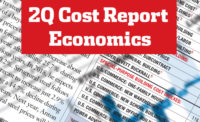The construction industry has seen some modest growth in the first quarter of 2024, but issues from the past several years are slow to recede.
“The early months of 2024 have not been without its struggles. Construction starts in January were very positive, but they fell sharply in February, with March also seeing a retrenchment,” says Richard Branch, chief economist at Dodge Construction Network. “The high interest rate environment, the continued scarcity of skilled labor and high material prices all contribute to the shortfall in activity.”
Dodge reports that the dollar value of starts is up 6% year-to-date compared to this time last year, though Branch notes that the first quarter of 2023 was “very weak.”
Related link: ENR 2024 1Q Cost Report PDF
Subscription Required
Residential Starts Are Split
In the residential sector, starts for single-family homes are “noticeably higher” than the first quarter of last year, as demand has risen. Multifamily starts, however, are down 9%, which Branch attributes to a current oversupply in units, resulting in higher vacancy rates. The largest multi-family projects to break ground in the last three months were the $1.5-billion One Beverly Hills Residences in Beverly Hills, Calif., and the 400 Lake Shore Drive Northern Tower building in Chicago.
On the non-residential side of construction, the dollar value of starts is up 2% through the first three months of 2024. “Commercial starts are flat with positive activity in retail and hotel offset by a decline in starts in warehouse and office buildings,” says Branch.
Manufacturing starts are down as well, at a rate of 15%, due to project delays as the labor shortage continues. On the positive side, education, recreation and transportation building starts have risen, leading to an overall increase in the institutional sector. The largest non-residential projects to get started in the first quarter of this year were the $5.5-billion Texas Instruments fabrication plant in Lehi, Utah, and the $2.6-billion redevelopment of Terminal B at George Bush Intercontinental Airport in Houston.
Non-building starts are up 16% year-to-date, as the benefits from the Infrastructure Investment and Jobs Act and Inflation Reduction Act continue to spur activity in the sector. Roads and bridges, environmental public works, gas/utilities and miscellaneous non-building—subcategories included—all saw growth year-to-date through March, according to Dodge. The largest non-building projects to begin this past quarter were the $1.1-billion Bull Run Filtration Facility in Gresham, Ore., and the $1-billion Eland Solar Farm in Mojave, Ca.
“Looking ahead, it is widely expected that the Federal Reserve will begin to cut rates by the midpoint of the year, and that should be the catalyst for a return to steady growth in construction activity,” says Branch. “Indeed, it’s reasonable to assume that developers and owners may be holding off on moving projects forward to start until the second half of the year when rates are slightly lower.”
Paul Brussow, president at cost consultant Rider Levett Bucknall, also points to public funding as a key factor in 2024. “I anticipate construction spending will be driven by public funding for manufacturing and infrastructure projects,” he says. “Significant investment in manufacturing and infrastructure will help offset a decline in privately funded projects in 2024.”
Overall, says Brussow, “My outlook for construction in 2024 can be summarized in two words: cautiously optimistic.”
Lumber Prices Steady
Softwood lumber prices are expected to drop 2.3% in 2024, following a 31.3% decline in 2023, according to S&P Global’s first quarter forecast.
“Softwood lumber prices have seen a modest increase to start 2024 as supply concerns push prices higher. North American lumber supply is tight right now as producers curtail some lumber mills and completely shut others,” says Luke Lillehaugen, senior economist at S&P Global. “The primary reason driving this supply tightening is high costs, but prices should stabilize soon as the spring construction buying season passes and market demand limits additional upward price movement.”
Plywood prices are expected to drop slightly, at a rate of 0.4%, in 2024, after falling 16.7% last year, according to S&P Global.






Post a comment to this article
Report Abusive Comment